Risk, Dynamic and Spatial Decision
Problems:
- Some
explaining graphs
by Peter
Lohmander, http://www.sekon.SLU.se/~PLO, Version
2000-09-06
This web page gives a very brief description of the
field "Risk, dynamic and spatial decision problems" within economic
forest management.
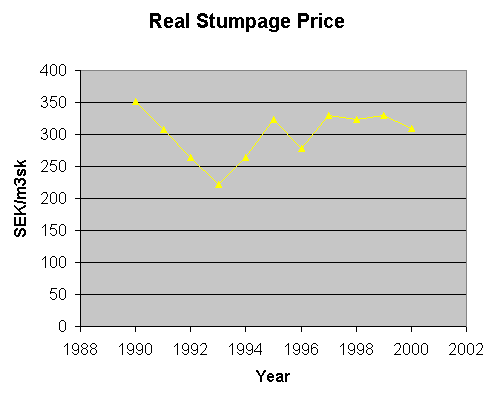
Figure
1.
The real (inflation adjusted) stumpage price in Sweden. Source:
Swedish Board of Forestry, Yearbook of Forest Statistics, 2000. We may regard
the stumpage price as a stochastic processes. There is no method available which
can predict future prices without error.
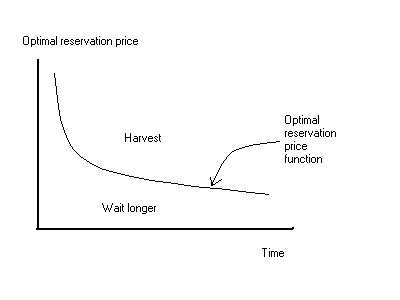
Figure
2.
Each period, you observe the development of the price. If the
price is higher than the reservation price, then you should harvest directly. If
the price is lower than the reservation price, then you should wait longer. If
the price is exactly equal to the reservation price, you may harvest directly or
wait longer. The optimal reservation price function may be determined via
stochastic dynamic programming. Here, you can read more about these things:
Lohmander, P., The economics of forest management under
risk, Swedish University of
Agricultural
Sciences, Dept. of Forest Economics,Report 79, 1987 (Doctoral
dissertation) (Doktorsavhandling), 311p
Lohmander, P., Pulse extraction under risk and a numerical
forestry application,
SYSTEMS ANALYSIS
-MODELLING - SIMULATION, Vol. 5, No. 4, 339-354, 1988
Lohmander, P., Adaptive decision making in forestry, in:
Paredes G. (editor), Forest
management and
planning in a competitive and environmentally concious world,
proceedings from: International Symposium on Systems
Analysis and Management
Decisions in Forestry,
March 9-12, 1993, Valdivia, Chile, 411-421, 1994
Lohmander, P., Reservation price models in forest
management: Errors in the
estimation of
probability density function parameters and optimal adjustment of the
bias
free point estimates, Management Systems
for a Global Forest Economy with Global
Resource
Concerns, Society of American Foresters, Asilomar, California,
September
1994, Brodie, D. & Sessions, J.,
(Editors),
College of Forestry, Oregon State
University, Corvallis, Oregon, USA, 439-456, 1995
Lohmander, P., Optimal sequential forestry decisions under
risk,
ANNALS OF OPERATIONS RESEARCH, Vol. 95,
pp. 217-228, 2000
Two different optimization programs which makes it possible to study optimal
harvesting decisions when prices are stochastic are found und here: http://www.sekon.slu.se/~PLO/javakod/D2.htm
and http://www.sekon.SLU.se/~plo/Stump00/Stump00.htm
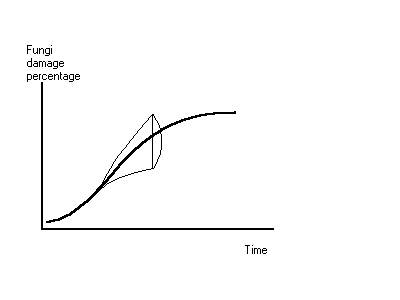
Figure
3.
The fungi damage percentage can not be perfectly predicted. We
have to regard that as a stochastic process. Predictions will include error
terms.

Figure
4.
Each period, you observe the development of the fungi damage
percentage. If the percentage is higher than the reservation percentage, then
you should harvest directly. If the percentage is lower than the reservation
percentage, then you should wait longer. If the percentage is exactly equal to
the reservation percentage, you may harvest directly or wait longer. The optimal
reservation percentage function may be determined via stochastic dynamic
programming.
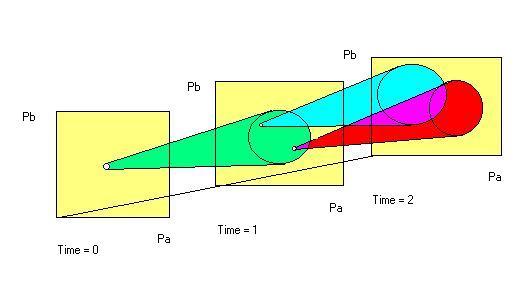
Figure 5.
Pa and Pb denote the prices (or species specific
growth parameters) of the species a and b. For reasons which are not
possible to predict perfectly, Pa and Pb change over time. At Time = 0, we may
invest in a mixed plantation. Then we know the values of Pa and Pb at that point
in time. At Time = 0, we use available statistical methods and predict that (Pa,
Pb) will come to some point in the green circle at Time = 1. At Time = 1, we
know to which particular point in the green circle we came. We can, at Time = 1,
select which species we want to keep growing in the forest until Time = 2. At
Time = 1, we make the predictions that we come to the blue circle or to the red
circle at Time = 2, depending on where we happen to be at Time = 1. Obviously,
it is valuable to be able to delay the species selection decision until Time =
1. This is only possible if we start with a mixed species plantation at Time =
0. Here you can read more about these multi stage decision problems:
Lohmander, P., Flexibilitet - en ledstjarna for all
ekonomisk skoglig planering,
SKOGSFAKTA,
Inventering och Ekonomi, No. 23, 4p, 1990
Lohmander, P., The multi species forest stand, stochastic
prices and adaptive selective
thinning, SYSTEMS
ANALYSIS - MODELLING - SIMULATION, Vol. 9, 229-250, 1992
Lohmander, P., Economic two stage multi period species
management in a stochastic
environment: The
value of selective thinning options and stochastic growth parameters,
SYSTEMS ANALYSIS - MODELLING -SIMULATION, Vol. 11, 287-302,
1993
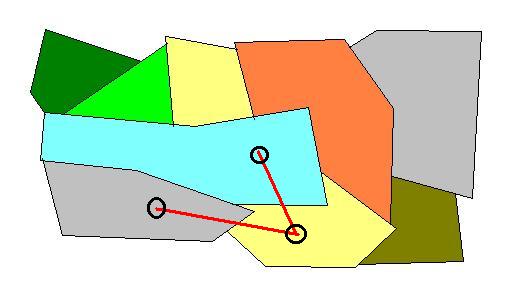
Figure 6.
There are economies of scale in harvesting
operations. One reason is that it is costly to move harvesters and forwarders
long distances. From traditional stand level forest management optimization
models, you easily get optimal solutions for individual stands. However, such
solutions are usually not optimal when we consider the complete forest. If you
take all spatial data and the costs of moving machines into account, it is
optimal to visit each area less often and to harvest more intensively when you
go there. Here you can read more about these and related issues:
Two abstracts on optimal forestry decisions in the presence
of risk and economies of scale:
http://www.sekon.SLU.se/~plo/abstr/SaltLC1.htm
Lohmander, P., Optimization of decentralized adaptive truck
decision rules: - A spatial
dynamic stochastic
forest company problem, paper presented at the "Natural Resource
Management Cluster" of the TIMS/ORSA meeting, Los Angeles,
April 23-26, 1995,
and at the general meeting of
Scandinavian Society of Forest Economics, Finland, 1996, in
Saastamoinen, O. & Tikka S., (Editors), SCANDINAVIAN
FOREST ECONOMICS, 36, 73-87, 1997
An optimization program which makes it possible to study how
changes in the costs of moving
harvesters and
forwarders affect the optimal thinning volumes and time intervals between
thinnings:
http://www.sekon.SLU.se/~plo/javakod/F4.htm

Figure 7.
Many kinds of damages have spatial patterns and
characteristics of relevance to optimal forest management decisions. The optimal
decisions in each stand are affected by the properties of (and activities in)
the other stands in the area. The graph shows the spread of a fire. The fire
starts in Stand 1 in the small yellow circle. Over time, the fire spreads to the
orange, to the yellow, and finally, to the red area. Of course, the wind
direction affects the spread direction. Clearly, the spatial pattern of stands
is of relevance to optimal forest fire management. The optimal management
decisions in forest stands are affected by the probabilities that forest fires
start in different parts of the area. These probabilities are to some
extent endogenous to the forest management decision problem. The options to stop
a fire which has already started are functions of the spatial distribution of
stands. Hence, the spatial distribution of stands and of forest management
activities should not be neglected. Insect-, fungi- and other damages sometimes
have similar characteristics.
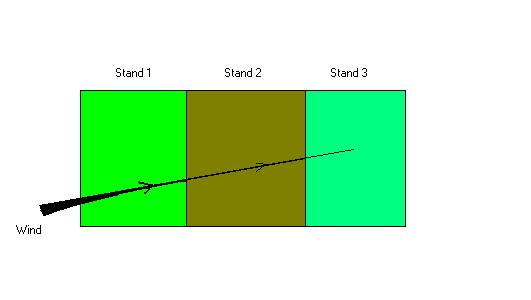
Figure 8.
Wind throws are economically important in some
areas. Wind damages are dependent on many factors. Some of these factors make
the optimization problems spatial. The physical properties and the spatial
position of each stand and the properties and positions of the neighbour stands
are all of importance to the optimal harvest decisions. Each stand in the area
may sometimes protect some other stands from the winds. In such areas, the
optimal harvest decisions can not be calculated stand by stand. It is often
optimal to harvest these stands simultaneously. This means the following: Some
stands should perhaps be harvested earlier than according to the optimal
solution in a single stand analysis. Some other stands should perhaps be
harvested later than according to the optimal solution in a single stand
analysis. Please, read more about these things here:
Lohmander, P., The economics of forest management under
risk, Swedish University of
Agricultural
Sciences, Dept. of Forest Economics,Report 79, 1987 (Doctoral
dissertation) (Doktorsavhandling), 311p
Lohmander, P., Helles, F., Windthrow probability as a
function of stand characteristics
and shelter,
SCANDINAVIAN JOURNAL OF FOREST RESEARCH, Vol. 2, No. 2, 227-238, 1987
Lohmander, P., Ekonomiskt optimal avverkning med hansyn till
stormfallningar,
SKOGSBRUKETS EKONOMI,
Skogsfakta Konferens, No. 11, 32-37, 1988
Welcome to the home page of Peter Lohmander for
more information!
http://www.sekon.SLU.se/~PLO
A forest economics java-library is found
here:
http://www.sekon.SLU.se/~PLO/javakod/Jlib1.htm







